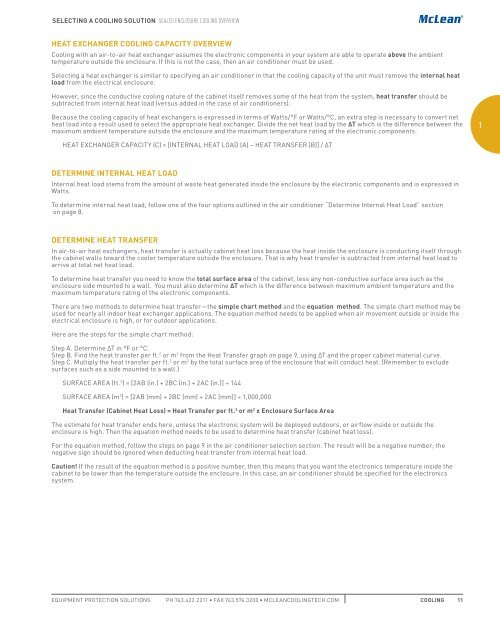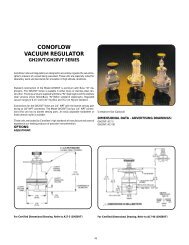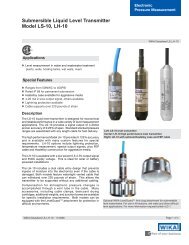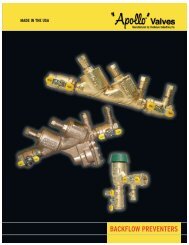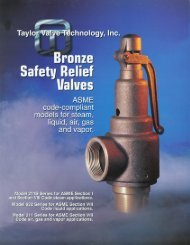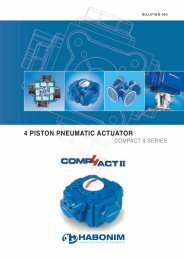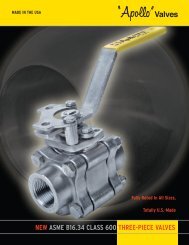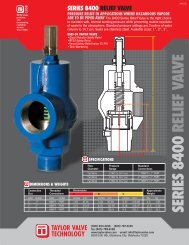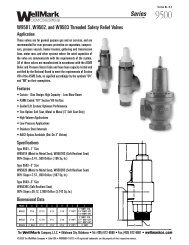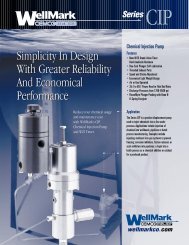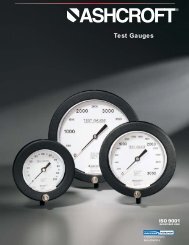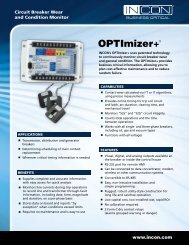SPECIFIER’S GUIDE
Download - McLean Cooling Technology
Download - McLean Cooling Technology
- No tags were found...
You also want an ePaper? Increase the reach of your titles
YUMPU automatically turns print PDFs into web optimized ePapers that Google loves.
Selecting A Cooling Solution Sealed EncloSURE Cooling oVERVIEW<br />
Heat Exchanger Cooling CAPACity Overview<br />
Cooling with an air-to-air heat exchanger assumes the electronic components in your system are able to operate above the ambient<br />
temperature outside the enclosure. If this is not the case, then an air conditioner must be used.<br />
Selecting a heat exchanger is similar to specifying an air conditioner in that the cooling capacity of the unit must remove the internal heat<br />
load from the electrical enclosure.<br />
However, since the conductive cooling nature of the cabinet itself removes some of the heat from the system, heat transfer should be<br />
subtracted from internal heat load (versus added in the case of air conditioners).<br />
Because the cooling capacity of heat exchangers is expressed in terms of Watts/°F or Watts/°C, an extra step is necessary to convert net<br />
heat load into a result used to select the appropriate heat exchanger. Divide the net heat load by the ΔT which is the difference between the<br />
maximum ambient temperature outside the enclosure and the maximum temperature rating of the electronic components.<br />
1<br />
HEAT EXCHANGER CAPACITY (C) = [INTERNAL HEAT LOAD (A) – HEAT TRANSFER (B)] / ΔT<br />
Determine InTERnal HEAT Load<br />
Internal heat load stems from the amount of waste heat generated inside the enclosure by the electronic components and is expressed in<br />
Watts.<br />
To determine internal heat load, follow one of the four options outlined in the air conditioner “Determine Internal Heat Load” section<br />
on page 8.<br />
Determine HEAT Transfer<br />
In air-to-air heat exchangers, heat transfer is actually cabinet heat loss because the heat inside the enclosure is conducting itself through<br />
the cabinet walls toward the cooler temperature outside the enclosure. That is why heat transfer is subtracted from internal heat load to<br />
arrive at total net heat load.<br />
To determine heat transfer you need to know the total surface area of the cabinet, less any non-conductive surface area such as the<br />
enclosure side mounted to a wall. You must also determine ΔT which is the difference between maximum ambient temperature and the<br />
maximum temperature rating of the electronic components.<br />
There are two methods to determine heat transfer—the simple chart method and the equation method. The simple chart method may be<br />
used for nearly all indoor heat exchanger applications. The equation method needs to be applied when air movement outside or inside the<br />
electrical enclosure is high, or for outdoor applications.<br />
Here are the steps for the simple chart method:<br />
Step A. Determine ΔT in °F or °C.<br />
Step B. Find the heat transfer per ft. 2 or m 2 from the Heat Transfer graph on page 9, using ΔT and the proper cabinet material curve.<br />
Step C. Multiply the heat transfer per ft. 2 or m 2 by the total surface area of the enclosure that will conduct heat. (Remember to exclude<br />
surfaces such as a side mounted to a wall.)<br />
SURFACE AREA (ft. 2 ) = [2AB (in.) + 2BC (in.) + 2AC (in.)] ÷ 144<br />
SURFACE AREA (m 2 ) = [2AB (mm) + 2BC (mm) + 2AC (mm)] ÷ 1,000,000<br />
Heat Transfer (Cabinet Heat Loss) = Heat Transfer per ft. 2 or m 2 x Enclosure Surface Area<br />
The estimate for heat transfer ends here, unless the electronic system will be deployed outdoors, or airflow inside or outside the<br />
enclosure is high. Then the equation method needs to be used to determine heat transfer (cabinet heat loss).<br />
For the equation method, follow the steps on page 9 in the air conditioner selection section. The result will be a negative number; the<br />
negative sign should be ignored when deducting heat transfer from internal heat load.<br />
Caution! If the result of the equation method is a positive number, then this means that you want the electronics temperature inside the<br />
cabinet to be lower than the temperature outside the enclosure. In this case, an air conditioner should be specified for the electronics<br />
system.<br />
EQUIPMENT PROTECTION SOLUTIONS PH 763.422.2211 • FAX 763.576.3200 • MCLEANCOOLINGTECH.COM<br />
Cooling 11


